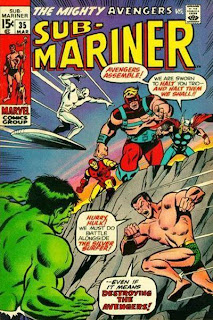 Of all the evil mutants the Defenders faced, Mandrill seemed the most driven by vengeance. As Mandrill described it, the torment he experienced as a child justified his criminal objectives.
Of all the evil mutants the Defenders faced, Mandrill seemed the most driven by vengeance. As Mandrill described it, the torment he experienced as a child justified his criminal objectives.
Unusual appearance notwithstanding, Mandrill's mutant pheromones enabled him to enslave a Fem-Force army of women. The women of the Defenders were just as susceptible to the intoxicating effects, turning them against their own teammates (Defenders #90).
- Hulk: Why does Valkyrie fight against Hulk? Valkyrie is Hulk's friend!
- Valkyrie: Bumbling brute! Such as yourself could never be a friend of the Valkyrie! Stand away, or feel the sting of my blade, Dragonfang!
- Hulk: Hulk doesn't understand--but if Valkyrie wants to hurt Hulk … Hulk will have to hurt Valkyrie.
Even with such chaos underfoot, the battle against Mandrill and his Fem-Force revealed how much the Defenders had come together as team.
- Hulk remained calm under pressure. When a mind-controlled Valkyrie drew her sword at the Hulk, he tried to reason with her before fighting.
- Valkyrie outgrew her allegory. Early incarnations of Valkyrie were decidedly feminist clichés (Avengers #83; Incredible Hulk #142). Seeing the character mind-controlled to join the one-dimensional Fem-Force showed how far removed Valkyrie of the Defenders truly was from such caricatures.
- Hellcat honed her psychokinesis. Despite her inability to control her psionic abilities since learning of them in Avengers #151, Hellcat successfully used the paranormal Shadow Cloak she acquired in Defenders #60 when attacking the women under Mandrill's command.
- Nighthawk lived up to his position as leader. After noticing that an electrical shock could free someone from the Mandrill's mental hold, Nighthawk used his resources at Richmond Industries to develop a bracelet that would emit an electrical pulse to protect against the villain's hypnotic power (Defenders #91).
- Daredevil returned! After several guest appearances as attorney Matt Murdock, the man without fear returned in costume to accompany the non-team during this adventure.








































































